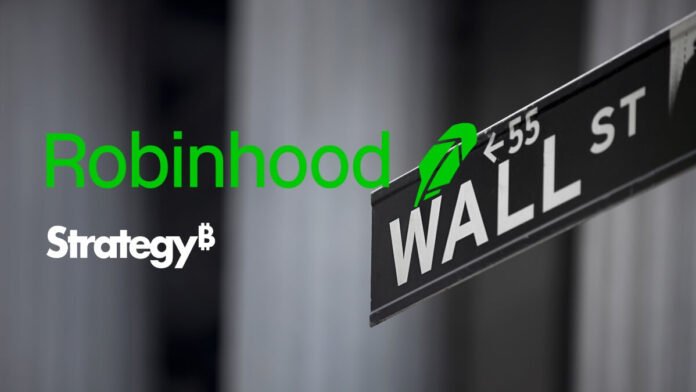What happened? The S&P 500 delivered a surprise on Friday. Robinhood Markets, the fintech known for stock and crypto trading, secured entry into the index. Meanwhile, Michael Saylor’s Strategy (MSTR), the world’s largest corporate Bitcoin holder, was left out despite meeting all eligibility criteria.
The S&P 500 reshuffle on Friday delivered a clear message to investors: Wall Street is warming to crypto—but only when it is integrated into diversified financial models. Companies built almost entirely around Bitcoin exposure remain a step too far for the index’s gatekeepers.
Robinhood’s Inclusion, Strategy’s Exclusion
Robinhood Markets (HOOD), the commission-free broker that has steadily expanded into crypto, credit cards, and wealth management, will officially join the S&P 500 on September 22. The announcement sparked a 7% after-hours rally, reflecting expected inflows from passive index funds.
In contrast, Michael Saylor’s Strategy (MSTR)—the largest corporate holder of Bitcoin—was passed over, despite meeting all technical requirements for inclusion and posting one of its strongest quarters ever. The stock fell nearly 3% after hours, erasing Friday’s gains.
For investors, the contrast is striking. Two companies with crypto exposure had divergent outcomes: one rewarded, the other sidelined. The difference lies in business composition, not in numbers.
Why Moderation Wins
The S&P 500 committee evaluates more than profitability and liquidity. It exercises discretion, weighing stability, diversification, and market risk. Strategy’s balance sheet, with more than 226,000 Bitcoin—valued above $25 billion at current prices—offers investors pure Bitcoin exposure through equity markets.
Yet this maximalist approach may have backfired. Analysts note that while Bitcoin has rallied to record highs this year, the volatility and regulatory uncertainty surrounding the asset class remain a concern for institutional allocators. By contrast, Robinhood earns part of its revenue from crypto but anchors its business in equities, options, retirement accounts, and now credit cards.
In Wall Street terms, Robinhood is diversified fintech with crypto upside. Strategy is Bitcoin in corporate form.
Implications for Institutional Investors
For institutional investors, the message is clear: crypto exposure is increasingly acceptable, but only in moderation. Firms like Coinbase, Block, and now Robinhood have all secured S&P 500 membership. Each integrates digital assets into broader ecosystems rather than positioning them as the sole driver of enterprise value.
This has practical implications for portfolio managers. Index inclusion forces passive funds to buy the stock, creating reliable inflows. Actively managed funds often follow suit, citing liquidity, visibility, and reduced tracking error. Robinhood stands to gain billions in passive inflows, reinforcing its legitimacy.
Strategy, on the other hand, missed that tailwind. While it remains a proxy for Bitcoin, investors seeking exposure may find it excluded from the passive flows that shape long-term valuation.
Lessons From Past Inclusions
Coinbase’s addition to the S&P 500 in May 2025 was hailed as a breakthrough for crypto. But even then, its inclusion came after regulatory clarity and years of operating as a regulated exchange. Jack Dorsey’s Block also secured entry with a diversified payments ecosystem that integrates Bitcoin services without being dominated by them.
In each case, moderation—not maximalism—was rewarded. Companies that balance crypto with broader financial offerings are perceived as safer entry points for institutional capital.
Strategic Takeaways for Investors
- Diversification matters. Companies with crypto exposure embedded into broader financial services are more likely to gain index legitimacy.
- Passive flows are powerful. S&P 500 inclusion can generate billions in forced buying, lifting stock prices and liquidity over time.
- Maximalist bets face barriers. Firms like Strategy provide pure Bitcoin exposure, but index committees remain reluctant to embrace volatility-heavy profiles.
- Regulation remains key. Investors should watch how U.S. regulators treat Bitcoin-heavy corporate structures, as policy clarity could shift committee decisions.
- Fintech is the bridge. Platforms like Robinhood are proving to be the gateway for crypto into mainstream financial indices.
The Bigger Picture
The decision reflects a broader theme: institutional adoption of crypto is advancing, but conservatively. Consulting firms like Deloitte forecast accelerating tokenization and digital asset integration into financial markets by 2030, yet note that the path will be incremental. McKinsey highlights that hybrid fintech models are best positioned for mainstream success.
Robinhood’s S&P 500 elevation underscores this trajectory. Investors seeking exposure to crypto within traditional portfolios may increasingly find fintech the safer, index-approved path. Strategy’s exclusion is not necessarily permanent, but it underscores the gap between investor enthusiasm for Bitcoin and institutional willingness to fully embrace it.
Wall Street has drawn a line….
Wall Street has drawn a line… Crypto is welcome, but only when wrapped in moderation, diversification, and stability. Robinhood represents that balance. Strategy, despite technical eligibility and record profits, remains a reminder that maximalism still carries institutional penalties.
For investors, the message is loud and clear: in today’s market, moderation gets rewarded—maximalism gets sidelined.
Read Also: Union Launches zk-Based Mainnet for Cross-Chain Liquidity, Secures $48M TVL
Disclaimer: This article is for informational purposes only and does not constitute investment advice.




